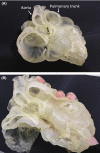Three-dimensional printing in congenital heart disease: A systematic review
- PMID: 29453808
- PMCID: PMC6119737
- DOI: 10.1002/jmrs.268
Three-dimensional printing in congenital heart disease: A systematic review
Abstract
Three-dimensional (3D) printing has shown great promise in medicine with increasing reports in congenital heart disease (CHD). This systematic review aims to analyse the main clinical applications and accuracy of 3D printing in CHD, as well as to provide an overview of the software tools, time and costs associated with the generation of 3D printed heart models. A search of different databases was conducted to identify studies investigating the application of 3D printing in CHD. Studies based on patient's medical imaging datasets were included for analysis, while reports on in vitro phantom or review articles were excluded from the analysis. A total of 28 studies met selection criteria for inclusion in the review. More than half of the studies were based on isolated case reports with inclusion of 1-12 cases (61%), while 10 studies (36%) focused on the survey of opinion on the usefulness of 3D printing by healthcare professionals, patients, parents of patients and medical students, and the remaining one involved a multicentre study about the clinical value of 3D printed models in surgical planning of CHD. The analysis shows that patient-specific 3D printed models accurately replicate complex cardiac anatomy, improve understanding and knowledge about congenital heart diseases and demonstrate value in preoperative planning and simulation of cardiac or interventional procedures, assist surgical decision-making and intra-operative orientation, and improve patient-doctor communication and medical education. The cost of 3D printing ranges from USD 55 to USD 810. This systematic review shows the usefulness of 3D printed models in congenital heart disease with applications ranging from accurate replication of complex cardiac anatomy and pathology to medical education, preoperative planning and simulation. The additional cost and time required to manufacture the 3D printed models represent the limitations which need to be addressed in future studies.
Keywords: 3D printing; congenital heart disease; model; simulation.
© 2018 The Authors. Journal of Medical Radiation Sciences published by John Wiley & Sons Australia, Ltd on behalf of Australian Society of Medical Imaging and Radiation Therapy and New Zealand Institute of Medical Radiation Technology.
Figures




Similar articles
-
A rapid and systematic review of the clinical effectiveness and cost-effectiveness of topotecan for ovarian cancer.Health Technol Assess. 2001;5(28):1-110. doi: 10.3310/hta5280. Health Technol Assess. 2001. PMID: 11701100
-
Interventions for interpersonal communication about end of life care between health practitioners and affected people.Cochrane Database Syst Rev. 2022 Jul 8;7(7):CD013116. doi: 10.1002/14651858.CD013116.pub2. Cochrane Database Syst Rev. 2022. PMID: 35802350 Free PMC article.
-
Cost-effectiveness of using prognostic information to select women with breast cancer for adjuvant systemic therapy.Health Technol Assess. 2006 Sep;10(34):iii-iv, ix-xi, 1-204. doi: 10.3310/hta10340. Health Technol Assess. 2006. PMID: 16959170
-
Eliciting adverse effects data from participants in clinical trials.Cochrane Database Syst Rev. 2018 Jan 16;1(1):MR000039. doi: 10.1002/14651858.MR000039.pub2. Cochrane Database Syst Rev. 2018. PMID: 29372930 Free PMC article.
-
Home treatment for mental health problems: a systematic review.Health Technol Assess. 2001;5(15):1-139. doi: 10.3310/hta5150. Health Technol Assess. 2001. PMID: 11532236
Cited by
-
A Systematic Analysis of Additive Manufacturing Techniques in the Bioengineering of In Vitro Cardiovascular Models.Ann Biomed Eng. 2023 Nov;51(11):2365-2383. doi: 10.1007/s10439-023-03322-x. Epub 2023 Jul 19. Ann Biomed Eng. 2023. PMID: 37466879 Free PMC article. Review.
-
A Systematic Review of Three-Dimensional Printing in Liver Disease.J Digit Imaging. 2018 Oct;31(5):692-701. doi: 10.1007/s10278-018-0067-x. J Digit Imaging. 2018. PMID: 29633052 Free PMC article.
-
3D printing as a pedagogical tool for teaching normal human anatomy: a systematic review.BMC Med Educ. 2023 Oct 20;23(1):783. doi: 10.1186/s12909-023-04744-w. BMC Med Educ. 2023. PMID: 37864193 Free PMC article.
-
Personalized Three-Dimensional Printed Models in Congenital Heart Disease.J Clin Med. 2019 Apr 16;8(4):522. doi: 10.3390/jcm8040522. J Clin Med. 2019. PMID: 30995803 Free PMC article. Review.
-
Learned iterative segmentation of highly variable anatomy from limited data: Applications to whole heart segmentation for congenital heart disease.Med Image Anal. 2022 Aug;80:102469. doi: 10.1016/j.media.2022.102469. Epub 2022 May 13. Med Image Anal. 2022. PMID: 35640385 Free PMC article.
References
-
- Australian Institute of Health and Welfare . Cardiovascular Disease Australian Facts 2011. Australian Institute of Health and Welfare, Canberra (Australia), 2011; pp. 220.
-
- Mitchell SC, Korones SB, Berendes HW. Congenital heart disease in 56,109 Births: Incidence and natural history. Circulation 1971; 43: 323–32. - PubMed
-
- van der Linde D, Konings EE, Slager MA, et al. Birth prevalence of congenital heart disease worldwide: A systematic review and meta‐Analysis. J Am Coll Cardiol 2011; 58: 2241–7. - PubMed
Publication types
MeSH terms
LinkOut - more resources
Full Text Sources
Other Literature Sources
Medical
Miscellaneous

